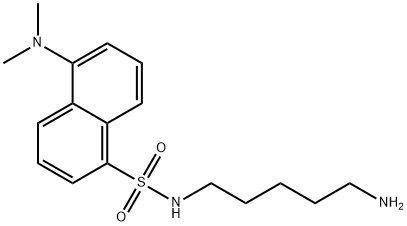Description
Monodansylcadaverine (MDC) is a fluorescent marker for autophagic vacuoles. It is an autofluorescent substance incorporated into multilamellar bodies by both an ion trapping mechanism and interaction with membrane lipids, exhibiting a Stokes shift and increased relative fluorescence in hydrophobic environments. MDC selectively accumulates in PaTu 8902 subcellular fractions containing the lysosomal enzymes acid phosphatase and cathepsin D, but not those containing the rough and smooth endoplasmic reticulum markers TRAM and cytochrome P450, respectively.
Uses
Lysosomotropic fluorescent Probe
Uses
Fluorescent substrate for the assay of transamidating enzymes.
Uses
Dansylcadaverine is a fluorescent amine probe, which is believed to directly inhibit vesicular transport. Studies indicate that Dansylcadaverine can act as a marker used to study autophagy in the cytoplasm and vacuoles of plants and mammalian cells.
Definition
ChEBI: Monodansylcadaverine is a sulfonamide obtained by formal condensation of the sulfo group of 5-(dimethylamino)naphthalene-1-sulfonic acid with one of the amino groups of cadaverine. It has a role as a fluorochrome, a protective agent and an EC 2.3.2.13 (protein-glutamine gamma-glutamyltransferase) inhibitor. It is a sulfonamide, an aminonaphthalene, a tertiary amino compound and a primary amino compound. It is functionally related to a cadaverine.
References
1) Munafo and Colombo (2001),?A novel assay to study autophagy: regulation of autophagosome vacuole size by amino acid deprivation; Int. J. Cell Sci.,?114?3619
2) Jiang?et al. (2012),?Targeting androgen receptor leads to suppression of prostate cancer via induction of autophagy; J. Urol.,?188?1361
3) Haigler?et al.?(1980),?Dansylcadaverine inhibits internalization of 125I-epidermal growth factor in BALB 3T3 cells; J. Biol. Chem., 255 1239
4) Murthy?et al. (1994),?Residue Gln-30 of human erythrocyte anion transporter is a prime site for reaction with intrinsic transglutaminase; J. Biol. Chem.,?269?22907


